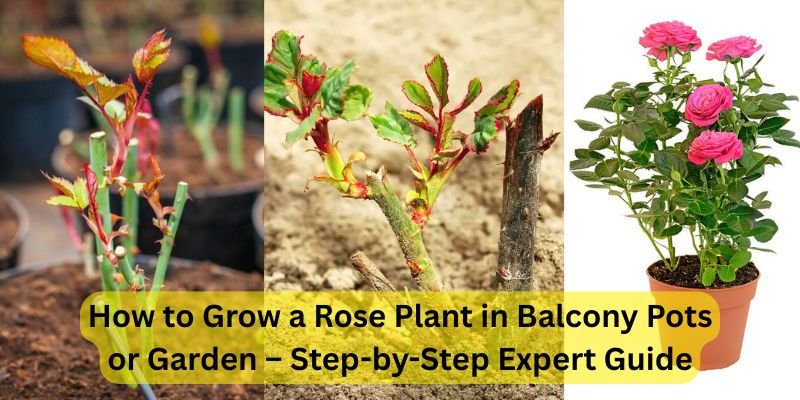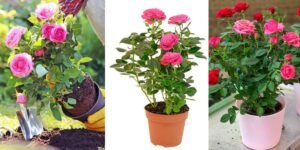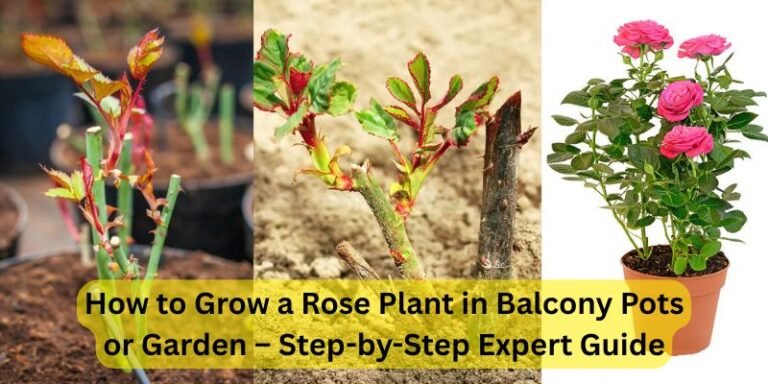
Professor Assistant Shoyab Ansari
How to Grow a Rose Plant in Balcony Pots or Garden:- Roses are more than just beautiful flowers; they are a symbol of love, grace, and nature’s delicate art. Whether you’re a gardening beginner or an experienced grower, cultivating a rose plant can bring charm and fragrance to your balcony or garden. This step-by-step guide will walk you through how to successfully grow and care for a rose plant in pots or open ground.

1: Choose the Right Type of Rose
Before planting, decide what type of rose you want. Common varieties suitable for home growing include:
Hybrid Tea Roses – Large blooms, ideal for pots.
Floribunda Roses – Compact and bloom in clusters.
Climbing Roses – Perfect for garden walls or balcony railings.
Miniature Roses – Best for small pots and limited space.
Tip: Choose disease-resistant varieties if you’re a beginner.

2: Select the Ideal Pot or Garden Spot
For Pots:
Use a minimum 12–16-inch diameter pot with good drainage holes.
Choose clay or ceramic pots for better aeration.
For Gardens:
Pick a sunny spot with at least 6 hours of sunlight daily.
Ensure the soil is well-drained and slightly acidic (pH 6.0–6.5).

3: Prepare the Soil Mix
A healthy rose starts with the right soil. Use the following mix:
40% garden soil
30% organic compost (cow dung, vermicompost)
20% sand or perlite (for drainage)
10% cocopeat or leaf mold (for moisture retention)
Note: Avoid salty or waterlogged soil.
4: Planting the Rose
In Pots:

Fill the pot halfway with soil mix.
Place the rose plant in the center.
Add more soil around the roots and press gently.
Water thoroughly.
In Gardens:

Dig a hole twice as wide as the root ball.
Add compost at the base.
Place the plant and cover with soil.
Water generously.

5: Watering Routine
Water 2–3 times a week, depending on weather.
During summer, water daily in the morning.
Ensure moist but not soggy soil.
Avoid overhead watering—water at the base.

6: Sunlight and Air
Roses love sunlight. Ensure:
6–8 hours of direct sunlight daily.
Good air circulation to prevent fungal diseases.
In balconies, place near the south-facing wall for best light.

7: Pruning and Deadheading
Prune in late winter or early spring. Remove dead, weak, or crossing branches.
Deadhead (remove spent flowers) regularly to encourage new blooms.
Always use clean, sharp tools.

8: Fertilization Schedule
Use a balanced NPK fertilizer (e.g., 10-10-10) once every 2–3 weeks during the growing season (spring to fall).
Apply banana peel, bone meal, or rose-specific organic feed for better flowering.
Stop feeding in winter.

9: Pest and Disease Control
Common rose pests:
Aphids, whiteflies, spider mites
Solutions:
Spray neem oil solution (5 ml/liter water) every 10 days.
Use insecticidal soap or garlic-chili spray as a natural repellent.
Common diseases:
Black spot, powdery mildew, rust
Solutions:
Avoid wetting leaves.
Use fungicidal sprays when needed.

10: Winter and Seasonal Care In winter, reduce watering.
Protect potted roses from extreme cold by moving them to a sheltered area.
Mulch with dry leaves or straw to retain warmth in the root zone.
Conclusion
Growing roses in balcony pots or a garden is both rewarding and therapeutic. With the right care, patience, and a bit of daily attention, your rose plant will bloom beautifully, adding color, fragrance, and joy to your living space. As with any plant, observation is key. The more you learn from your rose, the better you’ll get at caring for it.
So, roll up your sleeves, and let nature bloom in your home!




